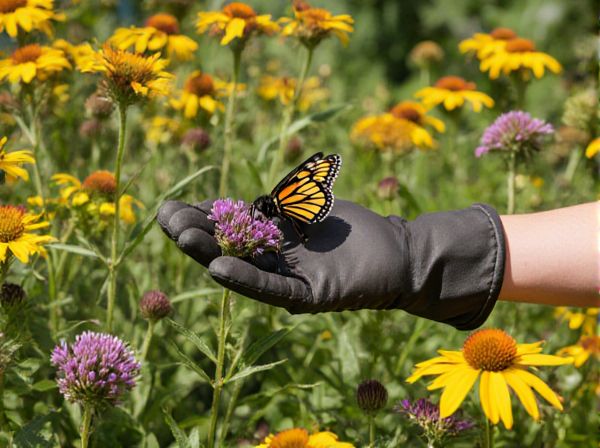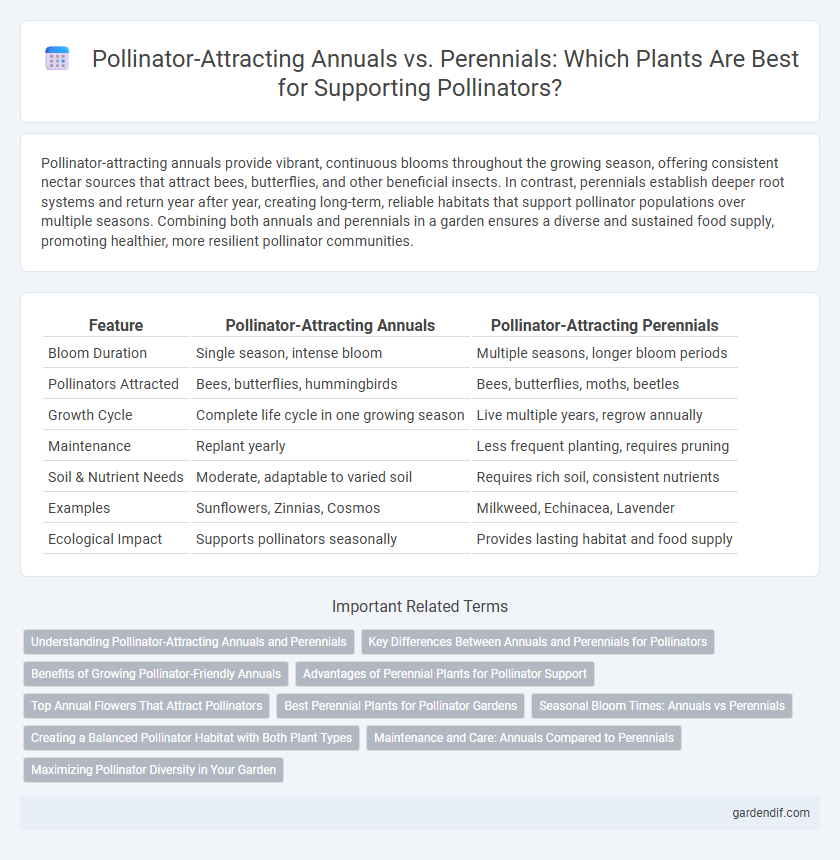
Pollinator-attracting Annuals vs Perennials Illustration
Pollinator-attracting annuals provide vibrant, continuous blooms throughout the growing season, offering consistent nectar sources that attract bees, butterflies, and other beneficial insects. In contrast, perennials establish deeper root systems and return year after year, creating long-term, reliable habitats that support pollinator populations over multiple seasons. Combining both annuals and perennials in a garden ensures a diverse and sustained food supply, promoting healthier, more resilient pollinator communities.
Table of Comparison
| Feature | Pollinator-Attracting Annuals | Pollinator-Attracting Perennials |
|---|---|---|
| Bloom Duration | Single season, intense bloom | Multiple seasons, longer bloom periods |
| Pollinators Attracted | Bees, butterflies, hummingbirds | Bees, butterflies, moths, beetles |
| Growth Cycle | Complete life cycle in one growing season | Live multiple years, regrow annually |
| Maintenance | Replant yearly | Less frequent planting, requires pruning |
| Soil & Nutrient Needs | Moderate, adaptable to varied soil | Requires rich soil, consistent nutrients |
| Examples | Sunflowers, Zinnias, Cosmos | Milkweed, Echinacea, Lavender |
| Ecological Impact | Supports pollinators seasonally | Provides lasting habitat and food supply |
Understanding Pollinator-Attracting Annuals and Perennials
Pollinator-attracting annuals, such as zinnias and cosmos, provide vibrant, high-nectar blooms that support pollinators throughout a single growing season. Perennials like echinacea and milkweed offer long-term habitat and recurring food sources, sustaining pollinator populations year after year. Understanding the complementary roles of annuals and perennials enables gardeners to create continuous, diverse forage that maximizes pollinator attraction and ecosystem health.
Key Differences Between Annuals and Perennials for Pollinators
Annual pollinator-attracting plants complete their life cycle in one growing season, offering a concentrated burst of nectar and pollen that benefits pollinators during specific months. Perennials provide consistent, reliable forage year after year, supporting pollinator populations with sustained floral resources and habitat stability. The choice between annuals and perennials influences pollinator diversity, as annuals often attract different species due to blooming timing, while perennials foster long-term ecosystem balance.
Benefits of Growing Pollinator-Friendly Annuals
Pollinator-friendly annuals provide rapid bloom cycles that supply immediate nectar and pollen resources essential for bees, butterflies, and hummingbirds throughout the growing season. These plants contribute to garden biodiversity by supporting a wide variety of pollinators, enhancing local ecosystems and crop pollination. Their flexibility in planting allows gardeners to adjust species composition yearly, optimizing seasonal attractiveness and habitat availability for diverse pollinator populations.
Advantages of Perennial Plants for Pollinator Support
Perennial plants provide continuous and reliable resources for pollinators by blooming over multiple seasons, ensuring sustained nectar and pollen availability. Their deep root systems enhance soil health and habitat stability, which supports diverse pollinator populations year after year. Investing in perennials reduces the need for frequent replanting, allowing ecosystems to establish and thrive with minimal disturbance.
Top Annual Flowers That Attract Pollinators
Top annual flowers that attract pollinators include sunflowers, zinnias, and cosmos, known for their vibrant colors and abundant nectar. These annuals bloom prolifically throughout the growing season, providing essential food sources for bees, butterflies, and hummingbirds. Planting a diverse mix of pollinator-attracting annuals supports local ecosystems and enhances garden biodiversity effectively.
Best Perennial Plants for Pollinator Gardens
Perennial plants like Echinacea, Monarda, and Asclepias provide consistent nectar and pollen sources, making them optimal for sustaining pollinator populations year after year. These species support a diverse range of pollinators including bees, butterflies, and hummingbirds, enhancing garden biodiversity through extended blooming periods. Incorporating native perennials ensures better adaptation to local pollinator needs and environmental conditions, promoting long-term ecological balance.
Seasonal Bloom Times: Annuals vs Perennials
Annual pollinator-attracting plants typically exhibit concentrated, vibrant bloom periods within a single growing season, providing intense bursts of nectar and pollen. Perennials offer extended, staggered bloom times across multiple seasons, supporting pollinator populations throughout the year. Selecting a combination of annuals and perennials ensures continuous floral resources for pollinators during varying seasonal conditions.
Creating a Balanced Pollinator Habitat with Both Plant Types
Including both pollinator-attracting annuals and perennials creates a balanced habitat that ensures continuous bloom and diverse nectar sources throughout the growing season. Annuals such as zinnias and cosmos offer vibrant, quick blooms that attract butterflies and bees early on, while perennials like coneflowers and bee balm provide reliable, long-term forage and shelter for pollinators. This mix supports a wider range of pollinator species, enhances ecosystem resilience, and promotes sustained pollination services.
Maintenance and Care: Annuals Compared to Perennials
Annual pollinator-attracting plants require replanting each year, making their maintenance more labor-intensive but allowing for seasonal variety in the garden. Perennials, however, establish deeper root systems and generally demand less yearly care, providing consistent blooms that support pollinators over multiple seasons. Choosing perennials often reduces water and fertilizer needs due to their established growth habits, while annuals may require more frequent watering and soil enrichment.
Maximizing Pollinator Diversity in Your Garden
Planting a variety of pollinator-attracting annuals and perennials ensures continuous bloom periods that support diverse pollinator species throughout the growing season. Annuals like cosmos and zinnias provide vibrant, nectar-rich flowers that attract butterflies and bees early in the season, while perennials such as coneflowers and bee balm offer reliable forage and nesting sites year after year. Combining both types maximizes habitat complexity and floral resources, fostering a thriving, diverse pollinator community in your garden.
Pollinator-attracting Annuals vs Perennials Infographic

 gardendif.com
gardendif.com